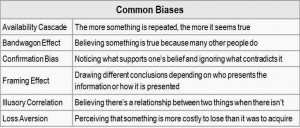How an ancient practice keeps entrepreneurs from deluding themselves and their investors
Thousands gathered this week in San Francisco at the Lean Startup Conference to hear industry luminaries share their expertise on how to launch successful startups. Conference hosts blogged about how innovative “Lean Startup” methods can reduce risk by rejecting the traditional path of extensive business planning and huge upfront investments. Instead, today’s top entrepreneurs formulate and test hypotheses, adjusting their new offerings quickly and cost-effectively with fast development cycles.
That’s right, the heart of today’s hottest management trend is a 2,500-year-old idea that you first learned in grade school. It’s the scientific method, one of Aristotle’s lasting contributions to humankind. He promoted the radical idea that new knowledge can be gained from empirical study of the natural world. Throughout the ages, Ibn al-Haytham, Roger Bacon, Descartes, and many others went on to perfect the concept. (1) Eventually, a 19th Century scientist and philosopher named William Whewell defined the five-step method commonly used today: formulation of a question, a hypothesis, a prediction, experimentation, and analysis of data to confirm or reject the hypothesis. (2)
Lean Startup is the scientific method
Today’s Lean Startup approach employs the scientific method to answer essential questions about new products, business models, and early market demand. Rather than generating lengthy market research reports, entrepreneurs list their hypotheses on a one-page “business model canvas.” Then, applying agile development techniques, founders work closely with customers to quickly test hypotheses and refine product features, pricing, marketing, and delivery. Following this path helps entrepreneurs prove that their products, key business processes, and economics all work on a small scale before they seek funding for rapid expansion.
This approach is not just for startups. Big companies General Electric, Toyota, and Comcast all use Lean start-up practices to develop new products and services with small teams, (3) an intrepreneurial practice that helps them avoid the bureaucracy inherent in large organizations. Many leading firms run ongoing, low-cost experiments, and then learn all they can from them, only committing massive money and resources when and if the business ideas demonstrate traction. Jim Collins, author of Good to Great and Great by Choice, calls this “firing bullets, then cannonballs.” He says following this critical discipline can help companies outperform financial benchmarks by a factor of ten or more over the long term. (4)
Angel investors and venture capitalists can also benefit from Lean Startup methods. It’s estimated that as many as 90% of new high-tech ventures fail, (5) meaning investors typically waste billions every year on ideas that go nowhere. The new approach limits risk for investors because it helps them methodically validate ideas using someone else’s (the founders’) boot-strapped funds. Financiers then avoid investing in ideas that arise from hopes and dreams alone, and substitute them with scientifically proven models based soundly on “dollars in and dollars out.”
Pass the pie in the sky
Perhaps the scientific method’s greatest contribution to startups is helping entrepreneurs overcome their own human shortcomings. All people suffer a cornucopia of flawed thinking—Wikipedia lists no less than 92 decision-making, belief, and behavioral biases.
Unfortunately, entrepreneurs tend to be in a class by themselves when it comes to bias. Being an entrepreneur often involves a steadfast belief in an idea that will be bigger than Google, regardless of what anyone else thinks. While that level of confidence is admirable, even infectious, it’s almost always self-deluding. Whether applied in the physical sciences or in business, the scientific method helps minimize bias and errant conclusions through repeated experiments, rigorous peer reviews, and credible evidence. In the end, objective reality always trumps subjective belief.
After a history of bad decisions and so much money wasted on dead ends, entrepreneurial approaches are changing. Increasingly, investor’s say “Prove it” when entrepreneurs claim to have the Next Big Thing. Thanks to the scientific method, the Lean Startup approach can do exactly that.
Excel-lens is a publication of Service Excellence Partners. Our unique approach helps founders at early stage companies better scale operations and manage growth. Contact us today.
Sources:
- De Lacy O’Leary (1949), How Greek Science Passed to the Arabs, London: Routledge & Kegan Paul Ltd., ISBN 0-7100-1903-3
- History of Inductive Science (1837), and in Philosophy of Inductive Science (1840)
- Lean Start-up Conference program, http://leanstartup.co/full-program
- Jim Collins and Morten T. Hansen (2011), Great by Choice: Uncertainty, Chaos and Luck—Why Some Thrive Despite Them All, USA: HarperCollins Publishers, ISBN 978-0-06-212099-1
- Max Marmer, Bjoern Lasse Herrmann, Ertan Dogrultan, Ron Berman. Start-Up Genome Report Extra. s.l. : Stanford University, 2012.


